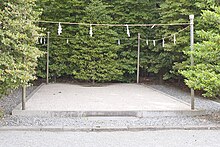

Himorogi (神籬, lit. "divine fence") in Shinto terminology are sacred spaces or altars used to worship. [1] In their simplest form, they are square areas with green bamboo or sakaki at the corners without architecture. These in turn support sacred ropes ( shimenawa) decorated with streamers called shide. [1] A branch of sakaki or some other evergreen at the center acts as a yorishiro, a physical representation of the presence of the kami, a being which is in itself incorporeal. [1] [2]

During the Aoi Festival in Kyoto the himorogi is a square space surrounded by green branches with an evergreen tree at the center as a yorishiro. [1] A more elaborate himorogi can also be made with a straw mat on the ground with on it a ceremonial 8-legged stand called an hassoku- an (八足案, eight leg an) decorated with shimenawa and sacred emblems. [1]
The etymology of the word is unclear, but it appears already in the Nihon Shoki and in the Man'yōshū. [1] The term "himorogi" refers equally to the focal point "tree" and to the sacred space, both of which are deemed to be purified or "unpolluted". [3]
Himorogi in Japan are most commonly seen at construction sites, where after use they stand for a while before actual work begins. They are built for a Shinto priest, who comes to bless the site during a ground-breaking ceremony called jichinsai (地鎮祭)
See also
- Koshintō
- Shintai
- The Glossary of Shinto for an explanation of terms concerning Japanese Shinto, Shinto art, and Shinto shrine architecture.
- Hiis (sacred site)
Notes
References
- Bocking, Brian. (1997). A Popular Dictionary of Shinto. Lincolnwood, Illinois: NTC Publishing. ISBN 9780844204253; OCLC 36977290
- Iwanami Kōjien (広辞苑) Japanese dictionary, 6th Edition (2008), DVD version
- Sugiyama, Shigetsugu. "Himorogi". Encyclopedia of Shinto. Retrieved 2008-07-18.